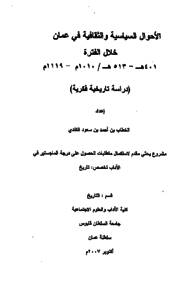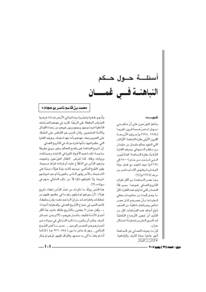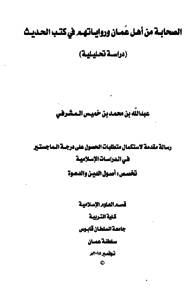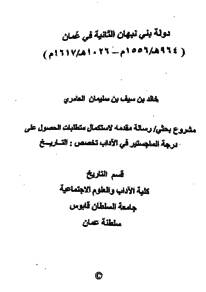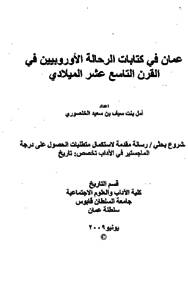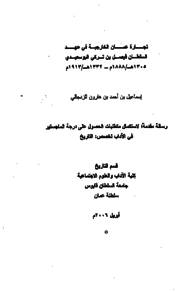وثيقة
الاحوال السياسية و الثقافية في عمان خلال الفترة 401هـ-513هـ /1010م-1119م
الناشر
جامعة السلطان قابوس
ميلادي
2007
اللغة
العربية
الموضوع
الملخص الإنجليزي
The main aim of the study is to explore and identify the Omani political and cultural issues. It focuses on correcting the commonly mistaken ideas regarding the chronological sequences of the ancient Omani Imams at that time. It also refers to the intellectual and cultural movements accompanied by the glory of culture represented by the writings of Fiqh (Jurisprudence) encyclopedias. To achieve the aims, the researcher tends to gain knowledge via reading ancient written texts. The study includes three major parts: the introduction, the preface, three chapters and the conclusion. The first part discusses the political life in Oman from 401 Hijri (1010 AD) to 513 Hijri (1119 AD). It also talks about the situation of Oman at the beginning of the specified era. How Omani people could defeated the invaders is also pointed out in this part. According to authentic recourses, the researcher mentions the history of Imams and their biographies. The second part is about the intellectual remains of two important schools of thoughts: Nizwania and Rustaqia. These were founded after the decline and the disposition of Imam Assalt bir Malik AlKharoosi (273 Hijri / 886 AD). The third part deals with the cultural situations and how it enriched the General Fiqh Encyclopedias. The conclusion clarifies the most important results of the current research. These include the changes in the chronological sequences of the Imams during that period and how the two schools of thoughts developed the Omani culture. The main findings of this study are listed below:
1. Bani Makram who ruled Oman in the early 5th Hijri /11th AD century were originally not Omanis. 2. Imam Rashid bin saeed Alyahmadi was leader in fighting the Bwaihis of Bani Makram until he died as a martyr. 3. Imam Alkhaleel bin Shathan Alkharoosi was the second Imam of that period. 4. The Rustaqi and Nizwani schools of thoughts had vital roles in flourishing the improvement of the culture in Oman. 5. Unlike the Nizwani School of thought, there is no clear evidence why the Rustaqi School was named after Rustaq town. It suppose to be called Bahla School of the thought as most of its member were from Bahla. 6. Internal and external reasons were behind the existence of Fiqh Encyclopedias.
الوصف
رسالة جامعية
المجموعة
URL المصدر
الملخص العربي
هدفت الدراسة إلى التعرف على أحوال عمان السياسية والثقافية وتصحيح بعض الأخطاء السائدة لدى المؤرخين السابقين في تسلسل أئمة عمان خلال هذه الفترة و التعرف على الحركات الفكرية والسياسية، وما صاحبها من ازدهار ثقافي تمثل في كتابة الموسوعات الفقهية. ولتحقيق ذلك أهتم الباحث باستقراء النصوص المختلفة التي دونها علماء ذلك العصر، ومن جاء بعدهم، ثم التعرف على حقيقة ذلك بالاستنتاج والاستقراء. والدراسة مقسمة إلى مقدمة وتمهيد وثلاثة فصول وخاتمة . فالفصل الأول ناقش الحياة السياسية في عمان خلال الفترة من عام من عام 401ه ۱۰۱۰م إلى عام ۱۳ مه ۱۱۱۹م وكيف كانت حالة عمان في مطلع فترة الدراسة وكيف أستطاع العمانيون طرد الغزاة وناقش سيرة الأئمة و تسلسلهم حسب ما استتتجه الباحث من المصادر أما الفصل الثاني فبحث الآثار الفكرية للمدرستين الرستاقية والنزوانية والتي نشأتا بعد عزل الإمام الصلت بن مالك الخروصي عام ۲۷۳ ه/ ۸۸۹ م وكيف كان الوضع الفكري لهما متبلورا خلال فترة البحث . وأما الفصل الثالث فبحث الحياة الثقافية وكيف أثرت الموسوعات الفقهية الشاملة التي برزت فيه الثقافة العمانية والأسباب التي أدت إلى ذلك . والخاتمة، أوضحت أهم النتائج المترتبة للبحث والمتمثلة في تغيير تسلسل الأئمة خلال هذه الفترة وكيف أثرت أفكار المدرستين الرستاقية و انزوانية على الحياة السياسية والثقافية في عمان، مستنتجة ما يلي : ا- أن بني مكرم كانوا يحكمون عمان في مطلع القرن الخامس الهجري الحادي عشر الميلادي وأنهم ليسوا من أصول عمانية . ۲_ أن الإمام راشد بن سعيد اليحمدي تصدر في مكافحة البويهين وعمالهم من بني مکرم حتی مات شهيدا . ٣_ أن الإمام الخليل بن شاذان الخروصي كان الإمام الثاني في هذه الفترة. 4 _ أن المدرستين الرستاقية و النزوانية كانتا ظاهرتين صحيتين جديرين بالدراسة ، ساهمتا في إزدهار الثقافة في عمان . ه_ لا يوجد دليل بين واضح لماذا نسبت المدرسة الرستاقية الى الرستاق ، أما المدرسة النزوانية فالدليل واضح ، فأولى أن يطلق على المدرسة الرستاقية بالمدرسة البهلانية لكون روادها من مدينة بهلاء أن ظهور الموسوعات الفقهية كانت له أسبابه الداخلية والخارجية .
قالب العنصر
الرسائل والأطروحات الجامعية

